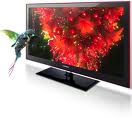Entelligence: The evolution of the TV (engadget)
By Michael Gartenberg
In a world of connected screens, the venerable TV continues to wait in isolation while the personal computer and the cell phone have become ubiquitously connected. Sure, there have been experiments in interactive TV -- gadgets like WebTV and modern game consoles are connected devices, and set-top boxes like the Roku and TiVo add connected components -- but most TVs in the US remain blissfully ignorant of the internet. There's arguably more TV content viewed on PCs than there is web content consumed on TVs. Here's why the TV remains disconnected and how that might change.
First, the PC and TV don't get along well. It's been a match that's been tried for more than a decade. It would seem like a no brainer: take a device with great connectivity and pair it with the TV. In the 90s Gateway introduced a line of Destination PCs that were designed for living room use, Microsoft later built some of the best TV and PC integration with their Media Center efforts, and even Apple has added a ten foot user experience to Mac OS with its Front Row UI. None of these efforts ever went mainstream. Why? Simple: PCs are designed for smaller screens, mice and keyboards, and TVs aren't. No matter what shell you layer on top, you're still stuck with a PC OS underneath that's not optimized for the TV experience.
Second, consumers don't want web content on their TVs. Even when it's possible, consumers have historically rejected the notion of online content on their TVs. Surveys show over and over there's simply no interest in email, web browsing, instant messaging or other online activities as discrete functions on the TV. While some services could no doubt be compelling on the TV, the lack of proper platforms, standards and user experiences make them awkward to implement, and the current TV widget platforms are simply too limited make much headway in capturing the consumer.
Your service provider already owns input one on your TV, and it has no intention of giving it up.
Third, and most importantly, cable and satellite providers simply aren't interested in opening up their boxes.Your service provider already owns input one on your TV, and it has no intention of giving it up. Even with government-mandated laws to allow access, consumers in reallty are offered few options to make third party solutions integrate with their television service. Devices such as the Roku or Apple TV have no way to connect to cable content, and even devices like TiVo that support CableCard are expensive to purchase relative to the "free" service provider box and require users to jump through hoops just make things work. CableCard issues also hampered PC / TV efforts that were well-thought-out, like Media Center, and by the time Microsoft sorted everything out, many consumers had simply moved on.
The irony, of course, is that the TV viewer has evolved independently of the TV. While users may not want online content on their TVs, they do seem to embrace TV content on their PCs. Ask a certain demographic to point to their TV consumption device and it will likely have a mouse and keyboard. Services like Netflix tied to devices such as the Xbox 360, Roku and TiVo mean there's alternatives to what's being served by cable and satellite companies. Over time, these options will expand and the TV itself will evolve -- it's just a matter of time before the TV and internet finally, finally get together.


